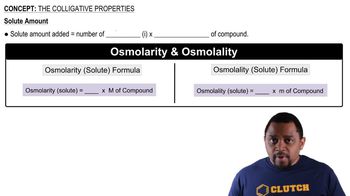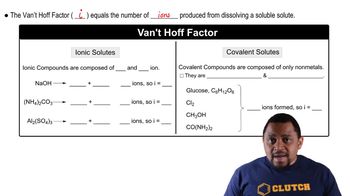Here are the essential concepts you must grasp in order to answer the question correctly.
Colligative Properties
Colligative properties are physical properties of solutions that depend on the number of solute particles in a given amount of solvent, rather than the identity of the solute. These properties include boiling point elevation, freezing point depression, vapor pressure lowering, and osmotic pressure. In this context, the boiling point elevation is particularly relevant, as it indicates how the presence of solute particles affects the boiling point of the solvent.
Recommended video:
Boiling Point Elevation
Boiling point elevation occurs when a non-volatile solute is added to a solvent, resulting in an increase in the boiling point of the solution compared to the pure solvent. This phenomenon is quantified by the formula ΔT_b = i * K_b * m, where ΔT_b is the boiling point elevation, i is the van 't Hoff factor (number of particles the solute dissociates into), K_b is the ebullioscopic constant of the solvent, and m is the molality of the solution. The greater the number of solute particles, the higher the boiling point.
Recommended video:
Van 't Hoff Factor (i)
The van 't Hoff factor (i) represents the number of particles into which a solute dissociates in solution. For example, NaCl dissociates into two ions (Na+ and Cl-), giving it an i value of 2, while glucose (C6H12O6) does not dissociate and has an i value of 1. This factor is crucial for calculating colligative properties, as it directly influences the extent of boiling point elevation in solutions.
Recommended video:




